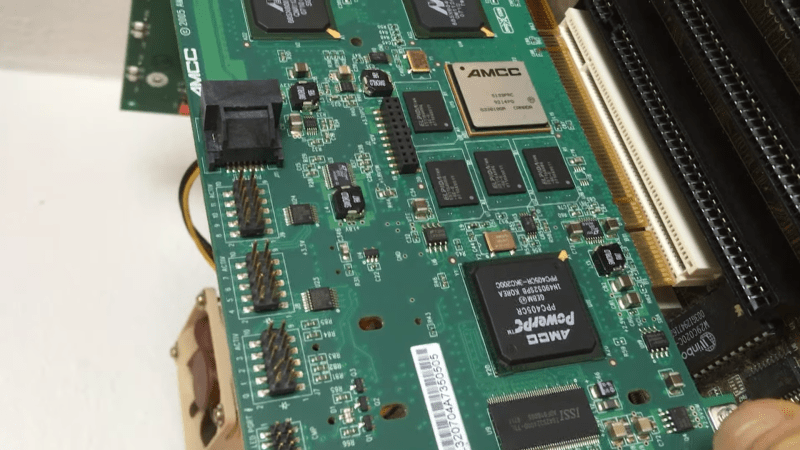PCI and PCI-X are not directly compatible, and you’d be forgiven for thinking that means you’re out of luck if you need to use a PCI-X card in a machine that only has basic PCI slots. And yet, that needn’t be the case. As [Peter] shows us, you can work around this with a cheap hacky hack. Our favorite kind!
[Peter] had a PCI-X RAID card that he wanted to use on his Socket 7-based computer. The 3ware 9550SX PCI-X card is 3.3 V only, and doesn’t fit in a typical PCI slot. It’s not compatible mechanically or electrically. Enter a PCI-X riser, which gets around the missing notch that would normally not let the card sit in the slot. Other than that, it just took masking off some pins to avoid damage from the 5 V rail. Throughput is good, too, reportedly sitting at roughly 60-70 MB/s.
The hard part is probably finding a PCI-X riser; PCI-Express stuff is far more common. Few of us need to deal with PCI-X anymore, but if you’re working on some ancient industrial hardware or something, this hack might just save your beans from the roast pot one day.

















> PCI and PCI-X are not directly compatible,
This generalization is just false.
Many PCI and PCI-X cards are compatible to PCI and PCI-X slots.
They are pretty much exactly as compatible as PCI cards to PCI sockets – the only difference is 3,3V / 5V / 3,3V & 5V
See https://en.wikipedia.org/wiki/PCI-X?useskin=vector#Versions
There may be mechanical problems when putting a PCI-X card in a PCI slot (because there may be components like caps in the way) but as long as the voltage “notches” fit …
PCI cards would definitely work fine in PCI-X slots, and I seem to remember fitting a PCI-X card (Maybe RAID?) which would work, abit slower, in a PCI slot, provided there was no components in the way.
Youtube shorts? Not on my watch! (points gun to the screen)
Having to peer through the boards of a privacy fence, VOV! Vertical Oriented Videos. Ugh.
(does not point at or click on) Mice are weapons.
Many PCI-X cards work just fine in PCI slots, no individual pin masking necessary. The 3.3V / 5V thing is more which IO voltage the card is using, and most cards are notched to work in either a 3.3V or a 5V slot. The only real problem you find is when a card is notched to fit in either slot, but lacks a 3.3V regulator onboard and expects 3.3V from the motherboard which may not be present on a 5V slot. This was one of the things people ran into with PC Radeon cards and Amiga bus boards or certain PCI macs. Sometimes you would have to solder on a missing 3.3v regulator to get the card to work in your Amiga or Mac. For the most part, you can just tape off the 64-bit part of the connector and go to town. The riser card is only necessary if you have components mounted in the way of the 64-bit extension hanging down (and you don’t feel like cutting it off the card).
And as others have pointed out, [Peter]’s real problem was trying to put a 3.3V card in a 5V slot.
For any one who doesn’t understand the real underlying problem here, please make sure to subscribe to my channel, as I’ll be making an indepth video soon. The short version: 3.3V-only cards are allowed by the PCI Standard to short the I/O voltage pins and the 3.3V supply. Not all are laid out this way, but the 9550SX is. So trying to run it in a 5V slot will result in a dead short of the 5V and 3.3V rail.
Pretty sure “70-80MB/s” doesn’t constitute “good” in this day in age.
I remember when 66mhz 32bit PCI was all the rage for raid cards, then came 64bit 66mhz pci slots, and then came along PCI-X, it enjoyed it’s limited time in the spotlight, but then the PCI-Express nation attacked.